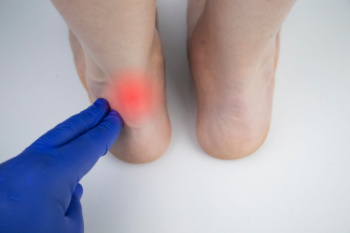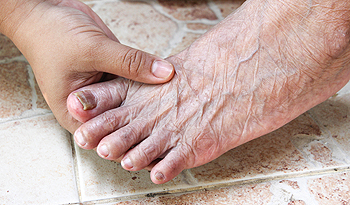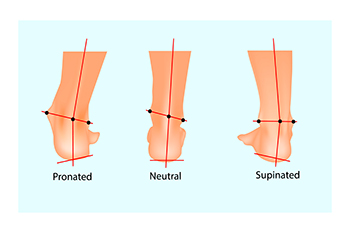
Foot ulcers are a complication for individuals with diabetes, often developing from poor circulation and nerve damage in the feet. These open sores typically form on weight-bearing areas, such as the bottom of the foot or the tips of toes, where the skin is more prone to pressure and injury. Without prompt care, diabetic foot ulcers can worsen, leading to serious infections that may spread to deeper tissues, including bones. Debridement, which is the removal of dead or infected tissue, and antibiotics are common treatments for managing foot ulcers. In some cases, surgery may be required to restore proper blood flow if the ulcer does not heal with standard care. Regular foot inspections are essential, especially for those with nerve damage, to help notice ulcers early before complications arise. If you have developed foot ulcers as a side effect of diabetes, it is suggested that you make an appointment with a podiatrist for an exam, diagnosis, and treatment options.
Diabetic foot care is important in preventing foot ailments such as ulcers. If you are suffering from diabetes or have any other concerns about your feet, contact Dr. Kendall Blackwell from InStride Wilson Podiatry Associates. Our doctor can provide the care you need to keep you pain-free and on your feet.
Diabetic Foot Care
Diabetes affects millions of people every year. The condition can damage blood vessels in many parts of the body, especially the feet. Because of this, taking care of your feet is essential if you have diabetes, and having a podiatrist help monitor your foot health is highly recommended.
The Importance of Caring for Your Feet
Patients with diabetes should have their doctor monitor their blood levels, as blood sugar levels play such a huge role in diabetic care. Monitoring these levels on a regular basis is highly advised.
It is always best to inform your healthcare professional of any concerns you may have regarding your feet, especially for diabetic patients. Early treatment and routine foot examinations are keys to maintaining proper health, especially because severe complications can arise if proper treatment is not applied.
If you have any questions please feel free to contact our office located in Wilson, NC . We offer the newest diagnostic and treatment technologies for all your foot and ankle needs.

Achilles tendon injuries are common among athletes, especially those involved in sports that require running, jumping, or sudden changes in direction, like basketball, soccer, pickleball, or tennis. The Achilles tendon, the largest tendon in the body, connects the calf muscles to the heel bone and plays an important role in walking, running, and jumping. Injuries can range from mild strains to complete tears, often caused by overuse, improper training techniques, or sudden increases in activity intensity. Symptoms usually include sharp pain, stiffness, and swelling near the heel. A ruptured Achilles tendon may be accompanied by a sudden pop and an inability to push off the foot. Treatment depends on the severity and can range from rest to surgery for more serious injuries. Proper conditioning, stretching, and wearing appropriate footwear can help prevent Achilles tendon injuries in athletes. If you are an athlete who has sustained an Achilles tendon injury, it is suggested that you schedule an appointment with a podiatrist for care.
Achilles tendon injuries need immediate attention to avoid future complications. If you have any concerns, contact Dr. Kendall Blackwell of InStride Wilson Podiatry Associates. Our doctor can provide the care you need to keep you pain-free and on your feet.
What Is the Achilles Tendon?
The Achilles tendon is a tendon that connects the lower leg muscles and calf to the heel of the foot. It is the strongest tendon in the human body and is essential for making movement possible. Because this tendon is such an integral part of the body, any injuries to it can create immense difficulties and should immediately be presented to a doctor.
What Are the Symptoms of an Achilles Tendon Injury?
There are various types of injuries that can affect the Achilles tendon. The two most common injuries are Achilles tendinitis and ruptures of the tendon.
Achilles Tendinitis Symptoms
Rupture Symptoms
Treatment and Prevention
Achilles tendon injuries are diagnosed by a thorough physical evaluation, which can include an MRI. Treatment involves rest, physical therapy, and in some cases, surgery. However, various preventative measures can be taken to avoid these injuries, such as:
If you have any questions please feel free to contact our office located in Wilson, NC . We offer the newest diagnostic tools and technology to treat your foot and ankle needs.

Toenail fungus is a common issue among the elderly, often overlooked but significant in maintaining overall foot health. As people age, their nails become thicker, more brittle, and slower to grow, creating an ideal environment for fungal infections. This condition, known as onychomycosis, typically begins as a white or yellow spot under the toenail and can progress to cause discoloration, thickening, and crumbling edges. For elderly people, toenail fungus can be particularly troublesome due to weakened immune systems and difficulty in maintaining foot hygiene. Regular inspection of the feet, keeping nails trimmed, and wearing breathable footwear can help to prevent infections. Treatment often involves topical antifungal creams or, in more severe cases, oral medication. If you are elderly or helping to take care of an elderly person, it is suggested that you schedule an appointment with a podiatrist if symptoms of toenail fungus appear.
If left untreated, toenail fungus may spread to other toenails, skin, or even fingernails. If you suspect you have toenail fungus it is important to seek treatment right away. For more information about treatment, contact Dr. Kendall Blackwell of InStride Wilson Podiatry Associates. Our doctor can provide the care you need to keep you pain-free and on your feet.
Symptoms
Treatment
If self-care strategies and over-the-counter medications does not help your fungus, your podiatrist may give you a prescription drug instead. Even if you find relief from your toenail fungus symptoms, you may experience a repeat infection in the future.
Prevention
In order to prevent getting toenail fungus in the future, you should always make sure to wash your feet with soap and water. After washing, it is important to dry your feet thoroughly especially in between the toes. When trimming your toenails, be sure to trim straight across instead of in a rounded shape. It is crucial not to cover up discolored nails with nail polish because that will prevent your nail from being able to “breathe”.
In some cases, surgical procedure may be needed to remove the toenail fungus. Consult with your podiatrist about the best treatment options for your case of toenail fungus.
If you have any questions, please feel free to contact our office located in Wilson, NC . We offer the newest diagnostic and treatment technologies for all your foot care needs.

Pronation and supination are movements that describe how your feet interact with the ground as you walk or run, significantly affecting your overall alignment and posture. Pronation refers to the inward roll of your foot during movement, while supination involves an outward roll. Ideally, your foot should move through a neutral position, balancing weight evenly across your foot. However, excessive pronation or supination can lead to pain in the feet, ankles, knees, hips, and even your lower back. Overpronation often flattens the foot’s arch, causing strain. Excessive supination increases pressure on the outer edge of the foot, potentially leading to shin splints or plantar fasciitis. A podiatrist can assess your gait, identify abnormal patterns, and recommend custom orthotics or specific footwear to correct these imbalances. If you often experience foot problems, especially after exercise, it is suggested that you schedule an appointment with a podiatrist for an exam, gait analysis, and treatment options.
If you have any concerns about your feet, contact Dr. Kendall Blackwell from InStride Wilson Podiatry Associates. Our doctor can provide the care you need to keep you pain-free and on your feet.
Biomechanics in Podiatry
Podiatric biomechanics is a particular sector of specialty podiatry with licensed practitioners who are trained to diagnose and treat conditions affecting the foot, ankle and lower leg. Biomechanics deals with the forces that act against the body, causing an interference with the biological structures. It focuses on the movement of the ankle, the foot and the forces that interact with them.
A History of Biomechanics
Modern technological improvements are based on past theories and therapeutic processes that provide a better understanding of podiatric concepts for biomechanics. Computers can provide accurate information about the forces and patterns of the feet and lower legs.
Understanding biomechanics of the feet can help improve and eliminate pain, stopping further stress to the foot.
If you have any questions please feel free to contact our office located in Wilson, NC . We offer the newest diagnostic and treatment technologies for all your foot and ankle needs.